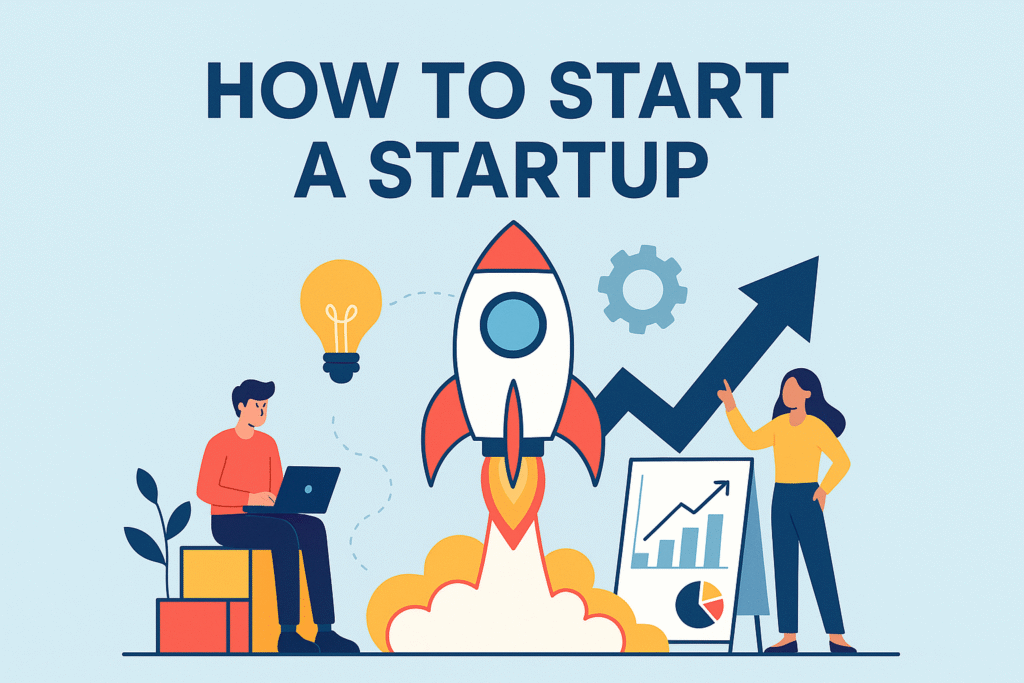Ever had a great idea that you felt could solve a real problem? Or maybe you’ve noticed something broken in your everyday life and thought, “There should be a better way to fix this.” If that’s you, then guess what you might be ready to start your own startup!
Starting a startup is no longer something only rich techies in Silicon Valley can do. With the right mindset, internet access, and a little hustle, anyone whether a college student, working professional, or passionate dreamer can build something amazing from scratch. So, let’s break it down, step by step.
Find a Problem Worth Solving
Every successful startup starts by solving a real problem. Look around you. Are there things that frustrate people? Something that wastes time, money, or energy? Something that could be made easier, cheaper, or faster?
You don’t need to invent something revolutionary. Even if your solution improves something that already exists, that’s good enough. The key is that your idea should be useful and actually make someone’s life better. That’s the foundation of any great business.
Validate Your Idea
Before you start building, make sure people actually want what you’re planning to offer.
Talk to real users — your friends, classmates, coworkers, or strangers in online groups. Ask them questions like:
- Do you face this problem often?
- Would you use a solution like this?
- Would you pay for it?
You can run online surveys using Google Forms, or join communities on Reddit, LinkedIn, or Discord to gather feedback. The earlier you validate your idea, the more time and money you’ll save down the road.
Build a Minimum Viable Product (MVP)
An MVP (Minimum Viable Product) is a basic version of your product that solves the main problem — nothing more, nothing fancy. It should be good enough to test whether people will actually use and benefit from it.
You can build your MVP using no-code tools like Bubble, Webflow, or Glide — even if you’re not a tech expert. Share it with a small group of users and collect feedback. Ask what they like, what’s missing, and what can be better.
Start small, test fast, and learn quickly. You can always improve later.
Research the Market
Before launching your product publicly, do a bit of homework. Find out:
- Who else is already doing this?
- How are they doing it?
- What can you do differently or better?
Also, figure out who your ideal customer is — their age, location, habits, and needs. This will help you market your startup more effectively.
Use tools like:
- Google Trends – to know what’s trending.
- Statista – for industry data.
- Uber suggest – to see what people are searching for.
- Answer The Public – to get common questions people ask online.
This kind of market research is not only helpful but also necessary if you ever plan to raise funds from investors.
Create a Simple Business Plan
No need to write a huge document — just a 1-page plan is enough in the beginning. Your business plan should answer:
- What problem are you solving?
- What’s your solution?
- Who are your customers?
- How will you make money (your revenue model)?
- How will you grow (your marketing plan)?
- What are your startup costs and funding needs?
This simple plan helps you stay focused and also makes a great first impression on potential partners or investors.
Choose a Co-Founder (Optional)
You don’t have to do everything alone. If you’re good at tech but not great at marketing, find a co-founder who can handle that part. If you’re good with sales but don’t know coding, team up with a developer.
Just make sure you choose someone you trust and can work well with. A strong co-founder can balance your skills, share responsibilities, and help you stay motivated.
Take Care of Legal Formalities
To run your startup smoothly in India, it’s important to register it officially. You can choose between:
- Private Limited Company
- Limited Liability Partnership (LLP)
- Sole Proprietorship
You should also:
- Apply for a GST number
- Open a business bank account
- Consider a trademark to protect your brand
Use platforms like Startup India, MCA, or Vakilsearch to handle the legal paperwork easily.
Launch and Get Your First Customers
Now it’s time to launch your startup and attract your first users. Don’t aim for millions on day one. Focus on getting just 10 real users who can give you honest feedback.
Here’s how you can find them:
- Post about your product on Instagram, LinkedIn, or Twitter/X
- Start a blog, YouTube channel, or podcast related to your niche
- Collaborate with influencers or micro-creators
- Join online communities on Reddit, Facebook, or Telegram
- Ask friends and family to refer your product to others
The goal here is to learn from your early users, not just sell.
Measure, Learn & Improve
Once users start using your product, pay close attention to their feedback. What do they like? What do they complain about? What features are missing?
Use tools like:
- Google Analytics – for tracking traffic
- Mixpanel / Hotjar – for understanding user behavior
- WhatsApp or Telegram groups – for direct chats with users
If something isn’t working, don’t be afraid to pivot or change direction. The best startups keep learning and improving constantly.
Raise Funds (If Needed)
In the beginning, try to bootstrap use your own savings or resources. It helps you stay in control and avoid pressure from outside investors.
Later, if your startup shows traction (real users, good feedback, some revenue), you can explore:
- Friends and family funding
- Angel investors
- Seed funding rounds
- Government schemes via Startup India
- Startup incubators like Y Combinator, Techstars, or 91springboard
Just remember: Investors invest in progress, not just ideas. So be prepared with results, a working product, and a solid plan.
Starting a startup isn’t about being perfect it’s about taking action, learning fast, and staying focused. You don’t need to be a genius or have tons of money to begin. You just need an idea, a plan, and the courage to start.
So if you’ve been waiting for the “right time,” this is it. Start small, stay consistent, and build something that matters.
By Himansh Kumar | July 11, 2025






